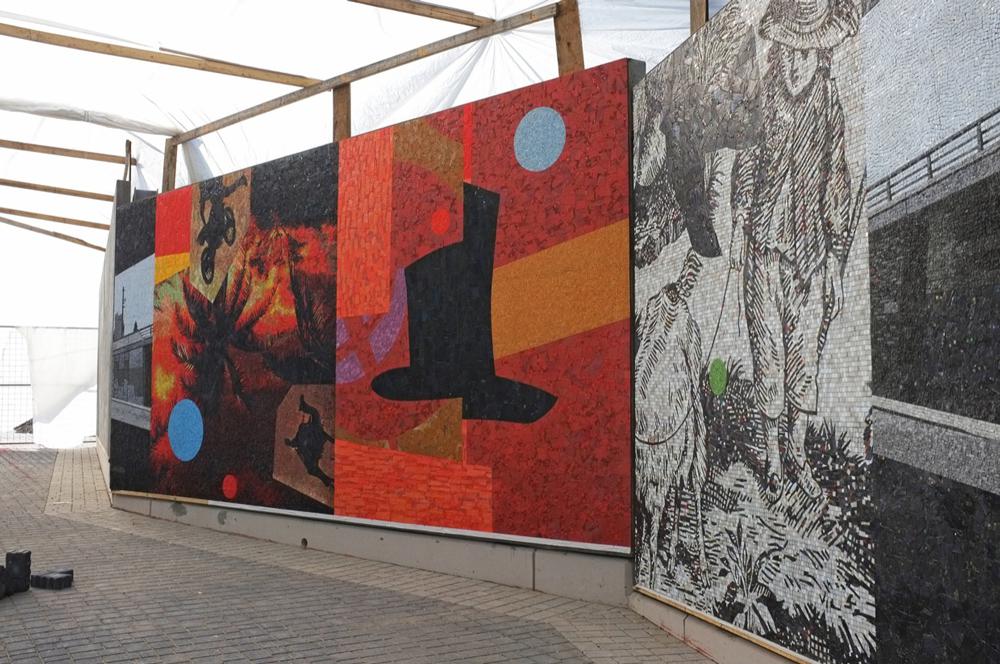Snow falling lightly from a grey sky could hardly diminish the saturated colour and richly variegated surfaces of a new public artwork unveiled last week in Calgary’s East Village. Instead, it set them off.
The work, Ron Moppett’s THESAMEWAYBETTER/READER, is a long mural made of more than 950,000 stunning mosaic tiles in a palette that ranges from black and white to vivid yellows, oranges, reds and blues. In sunlight, the tiles, highlighted here and there by iridescence or gold, sparkle and glint.
Commissioned by the Calgary Municipal Land Corporation, the mural runs for 110 feet along one side of the city’s first pedestrian-only street, Riverfront Lane, and rises up to 13 feet in height. It is the largest free-standing mosaic mural in Canada.
In April, the CMLC unveiled its first public commission, the 24-foot-tall LED sculpture Promenade by well-known British artist Julian Opie, which is visible from the Moppett mural. Both works are permanent installations.
“I like to think of it as my gift to the city,” Moppett said at the unveiling ceremony, observing that he emigrated from England with his family at the age of 12 and has lived in Calgary for 55 years.
The 67-year-old painter relates the mural, which unfolds in five accordion-angled sections, to a train. “It’s like an articulated vehicle, so sometimes I refer to it as a train of colour, as if each section were a carriage.”
The mural comprises Venetian and Mexican mosaic tiles as well as bits of granite and marble in the monochrome areas. The subject of its imagery—a mixture of abstract, representational and photo-based images—is an allegory of genesis and change in Calgary. Primeval plant life is visible in the first section. Palm trees in the second section pay homage to William Reader, a visionary who was Calgary’s first superintendent of parks and cemeteries from 1913 to 1942, and who managed to grow palm trees in Central Memorial Park.
Day turns to night and back again as colour passages change to black and white and back again. Glimpses of the site before the redevelopment of one of Calgary’s oldest neighbourhoods began appear in each section of the mural.
The project started with a year of discussions and design, during which Moppett worked out images on sheets of paper and bits of canvas. These were then sent as computer files to Mayer of Munich, a 165-year-old firm known for making mosaics and stained glass, in Germany.
Artisans at Mayer of Munich translated Moppett’s paintings, drawings and photographs into the small mosaic panels that were shipped to Calgary for assembly into the five sections.
The artist visited the Munich three times during the year it took to produce the mural. In his remarks, he noted the coincidence that Mayer of Munich installed several stained-glass windows in Calgary’s St. Mary’s Cathedral in 1957, the year he moved to the city as a boy.
Flat, coloured shapes, a characteristic of Moppett’s paintings and collages, are transformed in the mural into fields of many colours and textures, giving the imagery a different material quality and physical feel.
“What enthused me is that there are so many ways to lay the tiles. It’s not just big and little, it’s horizontal and vertical, it’s dark and light, it’s solid colour and patterns. The sides of the glass are different, too. You’ll have a chip of blue that is ever so imperceptibly different when you turn it. It’s one more way they can create differences for the eye.”
How does the painter appreciate the material transformations his work underwent? “There are times when you wish the paint could be a little more luminescent,” Moppett says. “When you get it right with the glass tiles, it’s magic. It was an excellent experience.
“I can’t wait to go back there.”









